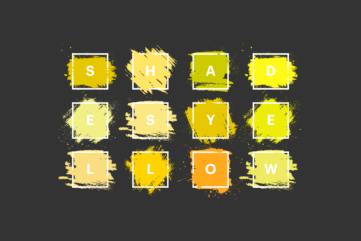Purple in marketing: What does purple mean in marketing

Utilizing purple in marketing can be an excellent way to boost the impact of your creative campaign. Unique, evocative, and interesting, purple can help to differentiate your company from other competing brands while giving depth to your brand identity.
However, before you can start experimenting with color palettes, it’s important to ask one crucial question: “what does purple mean in marketing?”
Color psychology tells us every shade, from the brightest white to the deepest red, directly impacts people’s emotions and behaviors. In marketing, leveraging the right color at the correct time can be an excellent way to convert your prospects into paying customers.
After all, experts tell us up to 95% of purchasing decisions are emotional.
Some shades are naturally correlated with certain types of marketing and promotion. When a company wants to announce a sale, they use red. They often use green and natural shades when highlighting their environmentally friendly practices.
Here’s what you need to know about using purple in marketing.

What does purple signify in marketing?
So, what does purple mean in marketing? This can be a tricky question because purple is a diverse and versatile color. Shades like blue are consistently connected with concepts like reliability, trustworthiness, and tranquility because they’re always cool and refreshing.
Purple, however, can have many tones, shades, and temperatures.
The exact hue you choose will alter the effects of your marketing on an emotional level. A dark purple logo and packaging might make your company look distinctive and mysterious, while a light purple shade is more likely to be connected with femininity and compassion.
From a psychological perspective, purple blends the energy of red with the calmness of blue. Sometimes, it can be used to soothe the mind and reassure customers. In other circumstances, it can inspire creativity, curiosity, and engagement.
The most common way to use purple in marketing is to signify luxury. The color has a longstanding connection with royalty and the upper classes.
As such, various leading brands like Cadbury, Hallmark, and many others have leveraged purple to show their elegant and indulgent nature. The color purple also has a deep link to the female sex.
For decades, female movements have embraced purple for their logos and advertising to connect with women worldwide. This means we’re more likely to see companies using purple for marketing when they want to reach a predominantly female audience.
How to use purple in marketing
There are various ways to utilize purple in the marketing world today. As an inventive and impactful color, bright purples are excellent for grabbing attention on landing pages when companies want their customers to click a button or make a purchase.
Purple can also be a comprehensive part of a company’s overall branding design. Shades of purple in a logo help to convey the nature of a business, forming deeper emotional connections with an audience.
A purple logo and website could convey compassion in lighter shades or luxury in darker, more regal hues.
Depending on your business, it’s possible to add purple to packaging strategies to make your product stand out on supermarket shelves. If other companies in your industry use different colors, purple can help to differentiate your business and demonstrate specific values held by your brand. The key things to remember when using purple in marketing are:
Know your audience
Make sure you understand what kind of audience you’re trying to reach when using purple. This color is standard in female-oriented industries like health, beauty, and technology, thanks to its link to innovation.
However, it’s not very popular among men, so it may only connect with some audiences.
Choose the right tone
Purple can be warm, inviting, cool, and sophisticated, depending on the shade you choose. Make sure you experiment with different color palettes to find the one with the right emotional impact. Some shades of purple may even seem arrogant or aggressive when misused.
Know your complementary colors
When producing a marketing campaign, think about the complementary colors you will use alongside purple. Too many bright or harsh colors used together can make your advertisements overwhelming. You may need to balance purple with other lighter shades.

When should you use purple in marketing?
There’s no one-size-fits-all strategy for using the right color in marketing campaigns. Once you know the answer to “what does purple mean in marketing,” you can begin to plan your strategies based on the extraordinary impact this shade can have.
Some of the best times to use purple in marketing include:
1. To appeal to a specific audience
As mentioned above, purple is most commonly connected with women and femininity, as women are more likely to prefer the shade than men.
Although it is possible to appeal to a broad audience with some purple campaigns, it’s worth remembering some of your audience may be driven away by too much of the color purple.
Make sure you research your audience and competitors before you build your marketing campaigns to ensure that purple will have the right impact.
2. Conveying mystery
Curiosity can be an incredible tool for marketers, as it encourages people to learn more about a product or service. Because purple is relatively difficult to find in nature, it’s commonly connected with the supernatural and spirituality. Some shades of purple are particularly mysterious.
If you want your business to come across as spiritual, or you’re hoping to spark curiosity in the customers you connect with, this could be the right shade to consider.
3. To show luxury
While purple can have many meanings in the psychological world, it’s most commonly connected with concepts of luxury and power. If you’re producing a high-quality item for an audience of high-spenders, then purple could be the ideal choice.
Purple makes a brand or product seem more exclusive and vital. This is why brands like Cadbury use purple in their packaging and branding to connect with customers searching for an indulgent experience.
4. Highlighting creativity
Some experts believe purple influences the part of the brain associated with creativity and imagination.
As a unique and intriguing color, it can be an excellent way for businesses to show their innovative side. This may be one of the reasons why so many technology companies have embraced the shade over the years.
If your business is introducing a new product that goes outside of the norm, then you can showcase your innovative nature by adding purple to your marketing mix.
5. To demonstrate compassion and beauty
Softer shades of purple are excellent for conveying ideas of beauty, compassion, and affinity. Countless companies in the health and beauty landscape use soft and pastel shades of purple to demonstrate their caring nature.
If you want to demonstrate your commitment to your target audience or the gentle nature of your products, then a paler shade of purple in your marketing and branding could be an excellent choice. Just make sure you use the right complementary colors too.
Is purple a good color for marketing?
Purple in marketing can have positive and negative effects on your target audience, depending on the context. If you want to position your brand as luxurious, compassionate, or innovative, purple could be one of the most effective colors.
Though this shade is relatively accessible today, it’s still correlated with exclusivity and excellence.
Innovative companies with creative products use purple to demonstrate their out-of-the-box thinking, while beauty and health companies rely on purple to show care and emotion. However, purple won’t be suitable for every brand’s marketing efforts.
If your business serves a lower-income group of consumers, then purple might come across as arrogant or overly exclusive. It can be associated with excess and extravagance. Some men see purple as excessively feminine, which may isolate some of your core demographic.
However you choose to use color in your marketing campaigns, it’s always helpful to get a deeper insight into the shades’ meanings and associations before diving in.
Fabrik: A branding agency for our times.
Now read these:
—Should you use purple in packaging design?
—Is purple a good color for logo design?
—Understanding the psychology of purple
—What does purple signify in branding?
—Why is purple associated with royalty?
—A guide to colors that complement purple
—Definitive guide to the shades of purple
—Popular companies with purple logos
—Your guide to which colors make purple
—Exploring the colors of the rainbow
















